Lost Animals

More than 1 million species of plants and animals are at risk of extinction.
That is 25% of the planet's species, based on the best estimates. In Massachusetts alone, there are 432 species that are either considered endangered, threatened or of special concern.
While it may seem unimportant if we lose a species here and there, it matters because each species, including humans, plays an important role and relies on other species to survive. The ecosystem becomes less stable as species go extinct until it eventually collapses. Extinction is irreversible and humans are part of the Earth's web of life. Human land use, particularly for agriculture, is the primary driver of biodiversity loss while the climate crisis is increasingly exacerbating the problem. Besides loss of species, loss of animal populations (without them going extinct) is a huge problem, too. In just over 40 years wildlife populations plummeted by 69%.
And now what?
Extinction Rebellion demands that leaders must
- Declare a climate and ecological emergency now.
- Immediate moratorium of commercial logging, drilling, and other extractive industries from conservation land and waters.
- Restore and expand critical habitats, focusing on endangered species diversity.
- Prioritize Indigenious knowledge and leadership in the planning and execution of these efforts.
What can you do?
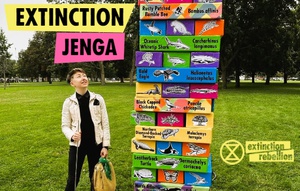
- Raise awareness to the ecological emergency, e.g. hang "Lost Animal" Posters in your neighborhood, or organize an Extinction Jenga event in your community
- Help to restore habitats and protest projects that cause local habitat loss in your community.
- We can help. Join Extinction Rebellion!
Some Examples of Endangered Species
Rusty Patched Bumble Bee
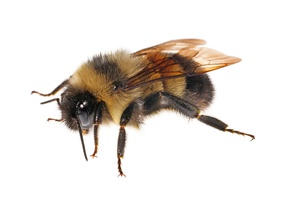
The Rusty Patched Bumble Bee was once common in New England and throughout much of North America. It was an excellent pollinator of wildflowers, cranberries and fruit trees. Primarily due to introduced pathogens, this species has lost 87% of its historic range and is now extinct in Massachusetts. Native bees are important pollinators of 75% of native plant species. Causes of native bee population decline also include climate change, pesticides and destruction of habitat.
Source: phys.org; BBC; Massachusetts Division of Fisheries & Wildlife
North Atlantic Right Whale
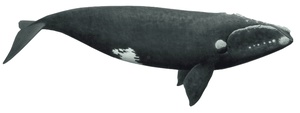
The North Atlantic right whale is critically endangered, with less than 450 animals left. Without intervention, they are expected to go extinct by 2040. Whales are threatened by fishing gear entanglement, commercial whaling, seismic testing, and climate change, which shifts their food sources and migration routes. Whales play a vital role in the health of the oceans by circulating essential nutrients throughout, helping to lock massive amounts of carbon from the atmosphere and provide up to 50% of our oxygen.
Source: Washington Post; whales.org
Black-capped Chickadees
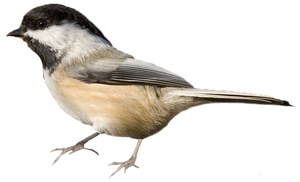
The Black-capped Chickadee is the Massachusetts state bird. Even though the Black-capped Chickadee is one of the most common and widespread bird species in the state, they are projected to go extinct in the state by 2050. Because of the effects of the climate crisis on its food source and the collapse of its habitat, their numbers are expected to decline and their distribution shift. The chickadee is one of the most important pest exterminators of the orchard or forest, because they eat large quantities of insects. The bird also pollinates plants and distributes seeds.
Source: birdwatchingdaily.com
Tiger
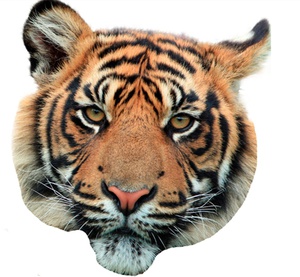
According to the World Animal Foundation, only about 5,570 tigers remain in the wild, which is 10% of their historical population and almost the same number of tigers than are held captive in the US alone. Tigers are endangered because of hunting, illegal wildlife trade, and habitat loss attributed to climate change. They have lost an estimated 95% of their historical range. As a large predator, tigers play a key role in maintaining the harmony of the ecosystem. By preying on herbivores, tigers help to keep the balance between the prey animals and the forest vegetation which they feed upon.
Source: WWF, World Animal Foundation
Loggerhead Sea Turtle
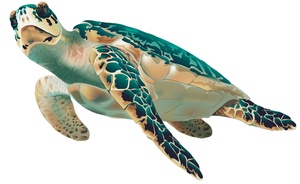
Sea turtles are endangered because of over-exploitation, habitat loss, and plastic pollution. Climate change harms turtle nesting sites: changes in sand temperatures causes an imbalance in sex distribution and dooms turtles’ ability to mate.
The Loggerhead sea turtle diet helps keep our ocean floor in balance, which contributes to overall ocean health. They are also hosts to an abundance of life: As many as 100 species of animals and plants have been recorded living on one single loggerhead turtle!
Monarch butterflies
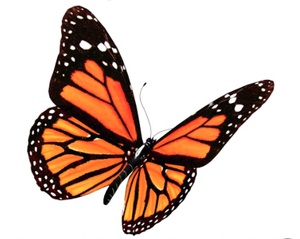
In 20 years, 85% of monarch butterflies have disappeared due to rampant use of pesticides, deforestation leading to habitat loss, and climate change, which causes a disruption of their migration patterns. Monarch butterflies travel every year across Canada, the United States, and Mexico, and spend their lives pollinating our flowers and edible plants like squash supplying one out of three bites that every American eats. Losing the Monarch butterfly and other pollinators means loss of our food supply across North America.
Source: National Geographic, Center for Biological Diversity
Marbled Salamanders
In the eastern United States, there are more salamanders than anywhere else in the world. However, diseases caused by wildlife imports, as well as climate change, droughts and toxins threaten these delicate creatures. When salamanders die, we know the planet's health is in trouble and that humans are next. Salamanders also protect human life by eating mosquitos and other insects that cause diseases like zika, dengue and malaria.
Source: USGS, Massachusetts Division of Fisheries & Wildlife
Bald Eagle
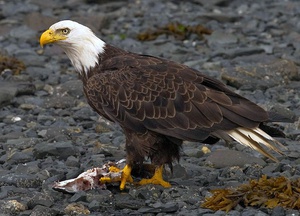
The bald eagle is an American symbol, the national bird since 1782 and the largest nesting bird of prey in Massachusetts. Bald eagles were pushed to the brink of extinction due to deforestation, hunting and poisoning with pesticides. Since the 1980s, MassWildlife and other conservationists, protected and restored the population, so that Bald eagles are no longer on the Federal Endangered Species List. However, they are still species of special concern protected by the Massachusetts Endangered Species Act and the avian flu threatens bald eagle recovery.
Source: MassWildlife, Boston.com, earth.com
Polar Bear
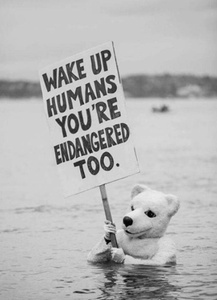
The loss of sea ice habitat from climate change is the biggest threat to the survival of polar bears. They rely heavily on sea ice for traveling, hunting, resting and mating. Temperature in the artic are rising twice at fast as anywhere and melting the sea ice. This leaves hungry polar bears with less hunting grounds. Polar bears are already 10% thinner than 30 years ago. Without polar bears to control the seals' population, the number of seals will subsequently increase, threatening the population of crustaceans and fish in the region.